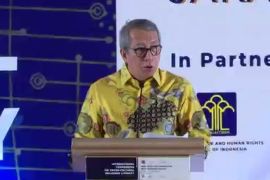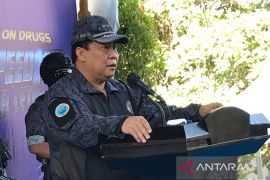The value of tolerance is practised regularly and widely across the region, with one of the most notable examples being side-by-side houses of worship in Batu Hitam, East Bunguran Sub-district, Natuna.
The two houses of worship, located in the Old Town of Penagi, are Al-Mukarramah Mosque, belonging to Muslims, and Pu Tek Chi Temple, belonging to Confucians.
The distance between the two houses of worship is approximately two meters, and the two buildings have similar sizes. Al-Mukarramah Mosque is currently undergoing renovation.
Despite being built side by side, no cases had yet been heard of religious groups complaining out of discomfort or prohibiting one another from doing their worship. The two religious groups have coexisted peacefully for many years.
Their tolerance is in the form of providing one another space to carry out the teachings of their respective religions according to the religions’ holy books.
High tolerance in the Old Town of Penagi, Natuna, earns the region the Religious Modernization Village status from the Ministry of Religious Affairs.
With the region decreed as a religious modernization village, it is hoped that the harmonious relations in Natuna can spread to several other regions in Indonesia. Eventually, it may strengthen inter-religious tolerance in the nation.
Apart from the Old Town of Penagi in Batu Hitam, East Bunguran, the Ministry of Religious Affairs also bestowed the same status upon Sedanau Sub-district.
Culture
Most people in Natuna are Malay and converse in the Malay language. What is interesting is that the Malay language used by people in Natuna is identical to the Terengganu Malay Language used in Malaysia.
Language similarity occurred, as the first leader of the region was Datuk Kaya, a descendant of the Patani Sultanate who once reigned over the northern part of the Malay peninsula, namely Kelantan and Terengganu.
Malay culture flourished in Natuna. However, Malay people on the island never prohibit other ethnicities from continuing their cultural traditions. Ethnicities outside Malay are free to perform or feature their cultures to express them.
An example of cultural diversity is the earth alms ceremony conducted by the Javanese people, who mostly live in the Central Bunguran Sub-district.
The Natuna District Government also assigned representatives to attend cultural events held by ethnicities outside of Malay.
Earth alms is a tradition commonly followed by the Javanese people once a year, usually after a harvest. The tradition is a form of gratitude to God for having provided them with sustenance through Planet Earth in the form of yields from their fields. The activity is usually enlivened by the Kuda Lumping dance, an art and cultural heritage from Java.

The local community never protests such activities. Instead, they enliven it and help those of other cultures look for necessities to create costumes and attributes.
The activity, which was attended by thousands of people from several ethnicities, was successful and lively. The same activity is planned to be conducted in 2024.
Helping Each Other
The high level of tolerance is also apparent from the warm welcome to the holidays, such as the Lunar New Year celebrated by the Confucians.
On Lunar New Year’s Eve, people from Chinese ethnic groups and religious groups with similar views in Natuna will decorate their temple and the road leading up to the temple with red lanterns. They also hang lanterns in front of their houses, and people from other ethnic groups usually assist in hanging the lanterns.
Another unique aspect is the lion dancers in the Pu Tek Chi Temple. They come from other ethnicities, namely Islamic Malays. Most viewers who watch the performance also come from other ethnicities and religions.
During the Islamic Holidays, people from other religions will enliven it in their own special ways, such as by coming along around the city on the eve of Eid (takbiran).
People owning grocery shops usually give out carbonated and canned beverages as bonuses for their Muslim customers. That way, Muslims can serve beverages to visiting guests on Eid.
Some people also donate money to youth organizations to make plug-in light installations as well as purchase fuel and other equipment to create the light installation that is usually assembled on the eve of Eid, both Eid al-Fitr and Eid al-Adha.
Through these examples, we can see that religious groups in Natuna are successful in sharing and providing space to respect each other’s religious and ethnic uniqueness and differences without feeling threatened or feeling that their beliefs and rights are being prohibited.
Natuna is a shining example that despite Indonesia being built on different religious beliefs, cultures, and ethnicities, it can still stand united in peace.
Related news: VP urges Indonesians to help maintain unity, harmony
Related news: Embracing Buddhist monks on Thudong, the face of Indonesia's tolerance
Editor: Tia Mutiasari
Copyright © ANTARA 2024












